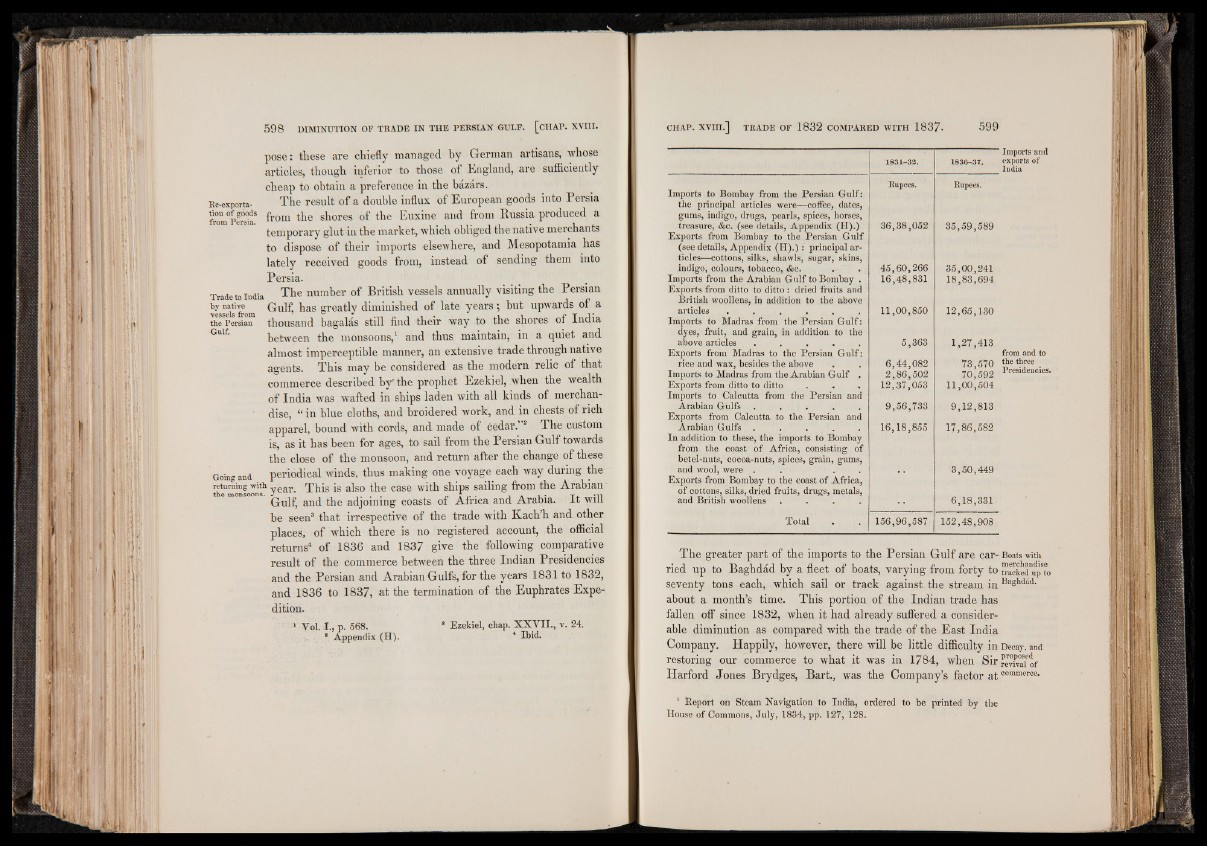
pose: these are chiefly managed by German artisans, whose
articles, though inferior to those of England, are sufficiently
cheap to obtain a preference in the bazars.
Re-exporta- The result of a double influx of European goods into Persia
tion of goods from the shores of the Euxine and from Eussia produced a
irom I cism# # . a i .
temporary glut in the market, which obliged the native merchants
to dispose of their imports elsewhere, and Mesopotamia has
lately received goods from, instead of sending them into
Persia.
Trade to India The number of British vessels annually visiting the Persian
by native Gulf, has greatly diminished of late years ; but upwards of a
theSpersia™ thousand bagalas still find their way to the shores of India
between the monsoons,1 and thus maintain, in a quiet and
almost imperceptible manner, an extensive trade through native
agents. This may be considered as the modern relic of that
commerce described by'the prophet Ezekiel, when the wealth
of India was wafted in ships laden with all kinds of merchandise,
“ in blue cloths, and broidered work, and in chests of rich
apparel, bound with cords, and made of cedar. 2 The custom
is, as it has been for ages, to sail from the Persian Gulf towards
the close of the monsoon, and return after the change of these
Going and periodical winds, thus making one voyage each way during the
thtUmonfoonsh year- This is also the case with ships sailing from the Arabian
Gulf, and the adjoining coasts of Africa and Arabia. It will
be seen3 that irrespective of the trade with Kach’h and other
places, of which there is no registered account, the official
returns4 of 1836 and 1837 give the following comparative
result of the commerce between the three Indian Presidencies
and the Persian and Arabian Gulfs, for the years 1831 to 1832,
and 1836 to 1837, at the termination of the Euphrates Expedition.
‘ Toi. I., p. 568.
' Appendix (H).
! Ezekiel, chap. XXVII., v. 24.
4 Ibid.
1831-32. 1836-3T.
Imports to Bombay from the Persian Gulf:
the principal articles were—coffee, dates,
gums, indigo, drugs, pearls, spices, horses,
Rupees. Rupees.
treasure, &c. (see details, Appendix (H).)
Exports from Bombay to the Persian Gulf
(see details, Appendix (H).) : principal articles—
cottons, silks, shawls, sugar, skins,
36,38,052 35,59,589
indigo, colours, tobacco, &c. 45,60,266 35,00,241
Imports from the Arabian Gulf to Bombay .
Exports from ditto to ditto : dried fruits and
British woollens, in addition to the above
16,48,831 18,83,694
articles . . . . . .
Imports to Madras from the Persian Gulf :
dyes, fruit, and grain, in addition to the
11,00,850 12,65,130
above articles . . . . .
Exports from Madras to the Persian Gulf :
5,363 1,27,413
rice and wax, besides the above 6,44,082 73,570
Imports to Madras from the Arabian Gulf . 2,86,502 70,592
Exports from ditto to ditto
12,37,053 11,00,504
Imports to Calcutta from the Persian and
Arabian Gulfs . . . . .
Exports from Calcutta to the Persian and
9,56,733 9,12,813
Arabian Gulfs . . . . .
In addition to these, the imports to Bombay
from the coast of Africa, consisting of
betel-nuts, cocoa-nuts, spices, grain, gums,
and wool, were . . . .
Exports from Bombay to the coast of Africa,
of cottons, silks, dried fruits, drugs, metals,
16,18,855 17,86,582
* * 3,50,449
and British woollens . . . . 6,18,331
Total 156,96,587 152,48,908
’ Imports and
exports of
India
from and to
the three
Presidencies.
The greater part of the imports to the Persian Gulf are car- Boats with
ried up to Baghdad by a fleet of boats, varying from forty to™acked”upto
seventy tons each, which sail or track against the stream in Bashdad-
about a month’s time. This portion of the Indian trade has
fallen off since 1832, when it had already suffered a considerable
diminution as compared with the trade of the East India
Company. Happily, however, there will be little difficulty in Decay, and
restoring our commerce to what it was in 1784, when Sir reviraTof
Harford Jones Brydges, Bart., was the Company’s factor a tcommerce-
1 Report on Steam Navigation to India, ordered to be printed by the
House of Commons, July, 1834, pp. 127, 128.